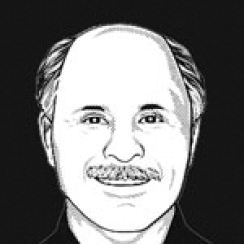
Illustration by Zoë van Dijk
All hail, King Dalio! The Bridgewater Associates founder claims first place on Institutional Investor’s Rich List — for the first time since his 2011 earnings propelled him to the No. 1 spot. How did he do it in 2018, a year when two thirds of all hedge funds lost money? Read on to find out, and to see what other managers — some longtime Rich List members, some first-timers — made our 18th annual Rich List ranking.
2019: $870 million
2018 rank: 3 ($1.4 billion)
Citadel enjoyed a strong year in what was otherwise a difficult environment for hedge funds. The multistrategy giant posted a more than 9 percent gain in its flagship Wellington Fund last year, topping most other multistrategy funds. Citadel’s Global Fixed Income Fund gained 6.59 percent in 2018, and Global Equities rose 5.92 percent. Wellington made money in all five of its core strategies, led by its equities strategy, which takes a fundamental, sector-focused, market-neutral approach. Commodities was the second-biggest contributor, followed by quantitative strategies.
Even so, Griffin saw his total earnings decline by nearly 40 percent. But that hasn’t slowed his spending, particularly when it comes to his considerable real estate empire. Earlier this year, Griffin plunked down about $238 million for a New York City penthouse, setting the record for the highest amount ever paid for a home in the U.S., according to The Wall Street Journal, and paid $122 million for a London home. He is also an ambitious philanthropist, having given away more than $700 million to date.
Earlier this year, Citadel reportedly told clients it is shutting down its Aptigon Capital stock trading unit after Eric Felder, who had headed up the unit, left the firm.
2019: $2 billion
2018 Rank: 4 ($1.3 billion)
Ray Dalio recently made headlines when he declared in an essay that capitalism is “not working well for the majority of Americans,” citing what he feels is a frighteningly widening gap between the haves and have-nots. But last year capitalism worked pretty well for Dalio himself.The macro maven tops this year’s Rich List after his flagship Pure Alpha macro strategy posted a 14.6 percent gain, its best performance since 2011. That netted Dalio a $2 billion payday. As Institutional Investor previously calculated, that works out to about $5.5 million per day — or $228,310 per hour if he worked 24/7.
Dalio, whose Bridgewater Associates is the world’s largest hedge fund firm, with $137 billion in assets, had been bearish for about a year and a half, which helped drive Pure Alpha’s gains last year.
“We don’t know exactly how far we are from the top in the stock market and then the economy,” Dalio wrote in February 2018 on LinkedIn, his favorite forum for communicating publicly. But he recently softened that stance, writing in late February 2019 that he is less worried about a recession now that growth is plunging.
“Because the markets weakened and Fed officials now see that the economy and inflation are weak, there has been a shift to an easier stance by the Fed,” he wrote on LinkedIn this past February. “Similarly, because of weaker markets, economies, and inflation rates in other countries, other central banks have also become more inclined to ease, though they have less room to ease than the Fed.”
Dalio recently published a new book, Principles for Navigating Big Debt Crises, following on the surprise success of his first book, Principles: Life and Work, published in 2017. That book is based on the firm’s famous Principles document, the driving force behind Bridgewater’s unusual — and sometimes controversial — corporate culture, which emphasizes radical transparency.
2019: $390 million
2018 Rank: Did not qualify
London-based macro specialist Alan Howard returns to the Rich List after a seven-year hiatus — the result of the firm posting its best gains since the financial crisis.Last year the Brevan Howard Master Fund rose 14.2 percent, its strongest performance since 2009. The AH Master Fund — which Howard personally manages — surged 30 percent. It charges just a 0.75 percent management fee . . . but a 30 percent performance fee.
The firm needed a good year: It had lost money in three of the four previous years as firmwide assets plunged to a low of $6.3 billion in 2018, from a peak of more than $40 billion in 2013. And on the back of a strong May (up 8 percent in that month alone) and a winning short on Italian government bonds, Brevan Howard had just that. (However, its Brevan Howard AS Macro Fund, a new macro fund, was up only about 0.45 percent in its first year.)
Howard previously worked on the Eurobond desk at Salomon Brothers, immortalized in Michael Lewis’s book Liar’s Poker. He moved to Tokai Bank’s London securities arm to head interest rate trading in Europe and then to Credit Suisse First Boston, where he was a trader and then head of proprietary trading for fixed-income in Europe. In 2002 he launched Brevan Howard alongside fellow traders Jean-Philippe Blochet, Christopher Rokos, James Vernon, and Trifon Natsis.
Each year, II determines the 25 hedge fund managers who personally earned the most money in a single year. We count gains on managers’ own capital invested in their funds, as well as shares of the firms’ total fees. When calculating the gains generated by managers’ own money, we do not take into consideration a high-water mark. In many cases, the gains on their capital play a major role in the ability of managers to qualify for the ranking — which was particularly true this year.
For the full list click here.
2019: $1.5 billion
2018 rank: 1 ($1.7 billion)
Everything is relative — especially when it comes to performance. The Renaissance Institutional Equities Fund returned 8.52 percent last year, the first time in six years it failed to produce a return in the double digits. But that gain qualifies as a stellar return for Simons’ computer-driven fund, given its mandate to generate gross annual returns of 4 to 6 percentage points above the S&P 500 over rolling three- to five-year periods using average leverage of about 2.5 to 1. Last year the index fell 4.4 percent. The firm’s Renaissance Institutional Diversified Alpha Fund rose 3.23 percent last year. Those gains helped Simons to No. 2 on the Rich List, after he topped the ranking the previous two years.
Simons, a Rich List regular, has shared those spoils. Late last year the Board of Trustees of the State University of New York approved changing the name of the Stony Brook University School of Medicine to the Renaissance School of Medicine at Stony Brook University. Over the years more than 100 current and former Renaissance employees have donated about $500 million to the university. Stony Brook previously named the Simons Center for Geometry and Physics in honor of Simons and his wife, Marilyn.
The philanthropically minded Simons also spends some of his enormous wealth on himself. Superyachtfan.com recently highlighted Simons and his 222-foot yacht, Archimedes, which sleeps 12 passengers and a crew of 18 and boasts a swimming pool and a grand piano, among other amenities, the report says. Simons also owns a $70 million Gulfstream G650 private jet, according to the website.
2019: $750 million
2018 Rank: 5 ($975 million)
Izzy Englander’s Millennium Management was one of the top-performing multistrategy firms last year, with its Millennium USA fund returning nearly 6 percent and its offshore counterpart gaining nearly 5 percent. That was enough to land Englander on the Rich List for the 17th time.Millennium cut its exposure by 20 percent in October amid the global stock market sell-off, according to an investor in the firm’s funds. As a result, the fund made money in December, when stocks once again sharply declined.
That performance undoubtedly helped Millennium raise $3.7 billion at the end of last year for a new five-year share class that limits investor redemptions to 5 percent per quarter, compared with the more common policy of 25 percent per quarter. This boosted the firm’s total assets under management to $37.9 billion as of year-end. The new Millennium class represents roughly 10 percent of the firm’s total capital.
Englander, the son of Polish immigrants, grew up in Brooklyn’s Crown Heights neighborhood. Englander and his wife, Caryl, donate large sums of money each year to a wide array of Jewish organizations and yeshivas, as well as to hospitals. He otherwise maintains a fairly low public profile.
2019: $820 million
2018 Rank: 10 ($570 million)
Last year may have been bad for the equity markets, but it was good for quant giant Two Sigma and its two founders, John Overdeck and David Siegel. The firm posted much stronger results in 2018 than in the previous year despite the widespread losses suffered by the equity markets. The firm’s Spectrum fund returned 9.9 percent, and the Compass fund rose 13.9 percent. As a result, the firm generated $3.2 billion in net gains for investors last year, landing it on an annual list of the most successful hedge funds of all time — by returns generated for their investors — published by LCH, a fund-of-funds firm. Two Sigma has generated $15.2 billion for its investors since its inception, according to LCH. Two Sigma now manages $59 billion, making it one of the world’s biggest hedge fund firms.
Overdeck and Siegel met at D.E. Shaw, where Overdeck headed up Japanese equity and equity-linked investments and supervised the firm’s London investment management affiliate. The low-profile fund manager has focused his philanthropy on mathematical literacy. The Overdeck Family Foundation, the Siegel Family Endowment, and the Robin Hood Foundation teamed up in 2015 to establish the $25 million Learning + Technology Fund, hoping to boost technology’s role in teaching low-income students in New York City.
The Overdeck foundation, chaired by Laura Overdeck, emphasizes providing educational opportunities, focusing on early childhood, educators, out-of-school STEM (science, technology, engineering, and math) training, and the use of data. Before working at D.E. Shaw, Overdeck was a vice president at Amazon.
2019: $820 million
2018 Rank: 10 ($570 million)
Two Sigma founders David Siegel and John Overdeck have referred to the quantitative fund management firm as a tech company that happens to invest. In an interview with Bloomberg last year, Siegel elaborated on that thinking.“Our vision is to focus on the capabilities of data science,” he told the newswire. “We think of investing as a data science problem. We think that by incorporating more and more information on the world into making investment decisions, we can do a better job.”
To that end, last year Two Sigma brought in Mike Schuster from Google Brainteam to expand its artificial intelligence efforts. Schuster reports to chief technology officer and Google alum Alfred Spector.
Earlier this year the Massachusetts Pension Reserves Investment Trust approved investing as much as $500 million in Sightway Capital, a Two Sigma company focused on private equity investments. Last year, Sightway raised $216 million for a collateralized fund obligation backed by stakes in 32 private equity funds.
In 2017, Siegel was honored — along with Overdeck — by the Academy of Achievement for being a pioneer in technology and investment management. His Siegel Family Endowment supports organizations that are helping to prepare society for the impact of technology, with funding for organizations including Scratch — which teaches kids computational thinking skills through coding — and efforts like Data and Society, a research institute that examines the social issues that can arise from pervasive technology.
2019: $465 million
2018 Rank: 8 ($600 million)
Chase Coleman — a descendant of Julian Robertson’s Tiger Management Corp. who got his start with seed money from the legendary manager — firmly cemented his stature as one of the premier long-short equity hedge fund managers last year.His firm posted a 13.6 percent net gain in its long-short fund, Tiger Global Investments. The fund made all of its money from short positions and private investments. The firm’s long-only fund, Tiger Global Long Opportunities, gained 3.4 percent last year, despite a 12.7 percent loss in the fourth quarter.
In October, Tiger Global’s venture capital operation raised $3.75 billion for Private Investment Partners XI, its 11th venture capital fund. The hedge funds and long-only funds also allocate small portions of their equity to private companies as part of their strategies.
Last year, Coleman and his wife, Stephanie, invited a select group to a post-gala party at their $52 million, East 66th Street co-op apartment, where they spent the evening playing beer pong and spray-painting the walls. The revelers included Paris Hilton and Keith Richards’ daughter Theodora, according to Page Six. The Colemans were preparing to combine the 15-room apartment they bought in 2016 with two apartments they own above it.
2019: $500 million
2018 Rank: 8 ($600 million)
D.E. Shaw’s flagship fund wasn’t just one of the top-performing multistrategy hedge funds last year — it was one of the best-performing hedge funds, period. The D.E. Shaw Composite Fund, which mixes quantitative and fundamental strategies, gained 11.2 percent after surging 3.6 percent in December. This topped its performance in the previous year, when the fund gained 10.2 percent.That performance helps explain why the firm announced earlier this month that it will restore the fund’s management fee to 3 percent and its incentive fee to 30 percent, starting next year. The fees were reduced from that level to 2.5 and 20 after 2011.
Last year, D.E. Shaw told clients it would return some of the profits generated by its Oculus Fund, which returned 6 percent in 2018. Its Valence fund rose 7.9 percent for the year.
Founder David Shaw, however, had little to do with this performance. He has not run D.E. Shaw on a day-to-day basis since 2001. The firm — which managed roughly $50 billion in invested and committed capital as of December 1 — is run by its executive committee: Anne Dinning, who rejoined the committee earlier this year after stepping down and moving to a part-time role in 2017; Eddie Fishman; Julius Gaudio; Max Stone; and Eric Wepsic.
These days, Shaw spends most of his time as chief scientist of D.E. Shaw Research and as a senior research fellow at the Center for Computational Biology and Bioinformatics at Columbia University. But he is said to remain involved in certain high-level strategic decisions at D.E. Shaw.
2019: $530 million
2018 Rank: Did not qualify
Crispin Odey’s obsessive bearishness — which has cost him dearly in the past — finally paid off last year. The Odey Asset Management founder went from laughingstock to stock market seer after his flagship Odey European fund posted a 53 percent gain amid equity market declines. That remarkable return followed three straight years of double-digit losses, including a roughly 50 percent decline in 2016 and a nearly 22 percent drop in 2017. As a result, London-based Crispin Odey, who founded his firm in 1991, qualifies for the Rich List for the first time strictly based on gains on his own capital in his funds. Odey, who supported Brexit, bet against the British economy, shorting the British currency and government bonds at the time. Last year the fund had big negative bets against U.K. government debt and Japanese government bonds, according to a Financial Times report. It also had a smaller short position on controversial electric carmaker Tesla. In addition, it made some money shorting U.K. shopping center owner Intu Properties after a proposed takeover collapsed, according to The Guardian.
Odey’s bearishness has not wavered — to the detriment of Odey European. The fund lost more than 10 percent in the first quarter, according to a document from investment bank HSBC that tracks hedge fund returns.





